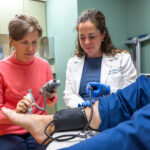
Daniel Gardone was the first patient worldwide to receive an innovative implant that uses a stent with tree-like branches to treat aortic aneurysms, bulges in the body’s main artery that can rupture, causing serious bleeding and possibly death.
Following Mr. Gardone’s back surgery in December 2014, an X-ray found an aneurysm in his arch, or the apex of the aorta, located at the top of his chest behind the sternum. The Penn Hills resident was quickly referred to Michel Makaroun, M.D., chief of the Division of Vascular Surgery at the University of Pittsburgh School of Medicine and UPMC.
Instead of undergoing major open heart surgery, Mr. Gardone opted in April 2015 to receive a new generation of implant — a thoracic branch endoprosthesis device — placed in the largest and first branch of the arch considered the most difficult and problematic location for such a procedure.
In June, during his one-year checkup, he received the good news: He was cleared for another year after his endovascular aneurysm repair.
“I chose what I had done because it was the least invasive option,” said Mr. Gardone, 64. “I have no major issues now other than a few minor aches and pains, but that is what happens when you get into your 60s.”
Between 12,000 and 15,000 people die from aneurysms of the aorta every year. Commonly found in the belly and upper body, aortic aneurysms mostly affect people 60 years old and older. Those at risk of developing one include people with high blood pressure, high cholesterol and atherosclerosis, as well as smokers. Symptoms can include throbbing or deep pain in the back or side, as well as pain in the buttocks, groin or legs, but oftentimes no symptoms are present.
The Division of Vascular Surgery at UPMC continues to investigate innovative treatment methods for these potentially deadly aneurysms, participating in three clinical trials using new state-of-the-art devices made of nickel titanium stents and covering materials of either Dacron or Teflon.
By providing blood supply through integrated branches similar to tree branches, the implant allows the complex aneurysms to be treated with a less invasive approach than previously used. For over 20 years, repair through small groin incisions has become the standard of care. However, the success of that minimally invasive approach is still limited when the aneurysm involves critical branches providing blood supply to the brain or abdominal organs.
 Companies now developing these complex products must test areas of fatigue and design connecting segments in lengths and diameters that can fit most patients, noted Dr. Makaroun.
Companies now developing these complex products must test areas of fatigue and design connecting segments in lengths and diameters that can fit most patients, noted Dr. Makaroun.
Physicians from the UPMC Heart and Vascular Institute have successfully implanted such branch devices into six patients thus far.
“This is the next phase in conquering areas that remain inaccessible today with standard devices,” Dr. Makaroun said. “These new advanced stent-grafts hold the promise of extending minimally invasive surgery to almost all aortic aneurysms, no matter the location.”
For more information about the UPMC Heart and Vascular Institute, click here.








